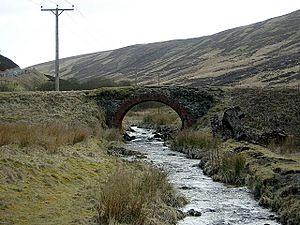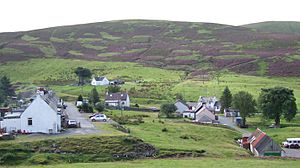George Bowes (prospector) facts for kids
George Bowes (died 1606) was an English prospector, which means he searched for valuable minerals like gold. He is known for his efforts to find gold in Scotland.
Contents
About George Bowes's Family
George Bowes was the son of Sir George Bowes and Dorothy Mallory. His family lived at Streatlam Castle. George married Magdalen Bray, whose father was Sir Edward Bray.
Mining for Coal and Copper
In 1595, George Bowes planned to open a coal mine on his own land called Beddick Waterville. Later, in 1602, he received permission to mine for copper. This copper mining took place on the Knowsley estate, which belonged to the Earl of Derby.
Around the same time, in 1602, Bowes and another person named Francis Needham looked at old copper mines near Keswick, at a place called Caldbeck. They found that these old mines also contained lead, which had some silver mixed in with it.
Searching for Gold in Scotland (1603)
George Bowes became very interested in finding gold in Scotland. He likely heard about the work of other miners like George Douglas of Parkhead and Cornelius de Vos. In 1603, Bowes wrote that King James VI had invited him to Scotland twice before he also became King of England. King James sent these invitations through Bowes's uncle, Robert Bowes, who was an ambassador.
Bowes wrote a paper explaining why he wanted to find gold in an area called Crawford Moor. He mentioned that he had experience mining in other parts of England, like Cornwall, Devon, Somerset, and Keswick. A landowner named Napier of Merchiston had even shown him samples of gold ore.
In December 1603, while at Leadhills, Bowes wrote to the Earl of Suffolk. He described the types of rocks and land in the area. He also mentioned that he had tried to work with Thomas Foulis, who had special permission from King James VI to mine for gold. However, Queen Elizabeth I had discouraged this partnership.
In another letter, Bowes shared a story from an old miner. The miner's father had supposedly found a rich vein of gold about 90 years earlier, during the time of King James IV or Regent Albany. The story said they had covered up and hidden this gold vein. Bowes was careful about believing these stories, as they came from workers of his rival, Bevis Bulmer, who might have wanted new mining jobs.
On December 29, 1603, Bowes, Napier of Merchiston, Bevis Bulmer, and John Brode sent a letter together from Edinburgh. They wrote to the Privy Council, a group of royal advisors. They explained that they had explored the gold mining area as King James had ordered. This order was given at Wilton in November.
Gold had been found before by Bulmer in several places, including streams that flowed into the Elvan water, on Steroc brae, and in the Glengonnar and Crawick waters. Even though a lot of gold had been found, they hadn't yet discovered a main vein of gold in the rock. Scottish miners hadn't looked for these veins until Bulmer and Thomas Foulis started digging for copper recently. The miners working for Bulmer said they hadn't found a vein either. The areas were very remote, meaning there were no houses for workers or managers. Timber for building homes would have to be brought from Leith, a port city.
Mining Efforts in 1604
In February 1604, George Bowes received £100 from the government to help him mine in Scotland. Bevis Bulmer also received £200 in January for gold mining in the same area. Bowes wrote letters to Robert Cecil, complaining that Thomas Foulis was causing problems for his work by holding back his English timber man. He hoped that Lord Balmerino, who was the Secretary for Scotland, would help him. Bowes stayed at Codrus Cottage, which was above Wanlock Water.
In March 1604, he wrote about a difficult winter trip to his mining sites at Wanlock Water. In February 1605, Nicolò Molin, who was the ambassador from Venice, reported on Bowes's progress. He heard that Bowes had told Queen Elizabeth about the Scottish gold mines, but she had arrested him. However, Bowes found support from King James and managed to produce 25 ounces of gold. But this cost a lot of money, and he was starting to lose people who supported his work.
On June 10, 1605, Bowes wrote to Robert Cecil again, from Biddick Waterville. He wrote about his search for gold near Wanlockhead in Scotland. He had asked for a large tent that could feed 80 workers. In 1604, he had found a promising area with yellowish clay and a type of rock called spar. He received another £200 to continue his work. In November, he began to mine there and drain the water from the pit. He also built houses on the land of Sir Thomas Kirkpatrick.
Bowes was not sure if he would find a lot of gold. On May 28, he rode to Edinburgh to tell Alexander Seton, the Lord Chancellor, and Lord Balmerino what he had found. Lord Balmerino visited and looked at Bowes's work and also Bevis Bulmer's mines. George Bowes stopped his mining efforts in June 1605 because he was not well. Bevis Bulmer then took over his mining permissions. George Bowes died soon after this.
In July 1606, George's wife, Magdalen Bowes, asked the Earl of Salisbury for money and help. She mentioned that George Bowes had held important jobs, like being in charge of Raby Castle and managing the lands of Charles, Earl of Westmorland. While George was away in Scotland, others took over these jobs. George had to pay them to get his jobs back. Magdalen said that his copper mining work at Keswick and Knowsley during Queen Elizabeth's time had caused him injuries and illnesses that shortened his life. The Earl of Dorset had given these two jobs to their oldest son, also named George Bowes, but others were making it difficult for him.
Stephen Atkinson, a writer, said that "Mr Bowes" had found a vein of gold at Wanlock Water, which Bevis Bulmer later used. Atkinson stated this happened when Queen Elizabeth was still alive. Before this, gold mines had been opened by Cornelius de Vos and George Douglas of Parkhead. The British Library has a short description of gold mining in Scotland that might have been written by George Bowes in 1603, asking for money to fund his work.
George's older brother, Robert Bowes, died in an accident at a copper mine in Keswick in 1610.
George Bowes's Children
George Bowes and Magdalen Bray had several children, including:
- George Bowes, born May 6, 1596.
- Robert Bowes, born September 29, 1597, who married Joan Hutton.
- Bray Bowes, born January 2, 1603.
- Ralph Bowes
- Toby Bowes of the Waterside.
- William Bowes, born August 12, 1599.
- Dorothy Bowes, born February 7, 1604.
- Magdalen Bowes, born February 4, 1593.





